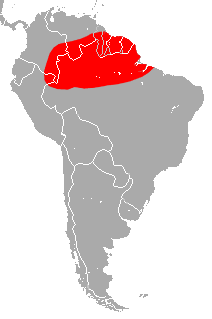Lesser ghost bat
| Lesser ghost bat | |
|---|---|
| Scientific classification | |
| Domain: | Eukaryota |
| Kingdom: | Animalia |
| Phylum: | Chordata |
| Class: | Mammalia |
| Order: | Chiroptera |
| Family: | Emballonuridae |
| Genus: | Diclidurus |
| Species: | D. sctutatus
|
| Binomial name | |
| Diclidurus sctutatus | |

| |
| Lesser ghost bat range | |
The lesser ghost bat (Diclidurus scutatus) is a bat species found in South America.[1] It is one of six bat species worldwide to have white fur.
Taxonomy and etymology
It was described by Wilhelm Peters in 1869 based on a specimen sent to the Paris Museum of Natural History by Arsène Onessim Barraquin.[2] Barraquin had collected the specimen in Paraguay in 1859.[4] Peters placed it in the genus Diclidurus.[2] Its specific name, scutatus, is of Latin origin, meaning "shield-shaped". Its lineage diverged from other members of its genus around 5 million years ago at the end of the Miocene.[5]
Description
It has long, soft fur that is white or pale brown in color.[6] It is one of only six bat species worldwide that have white fur; others are the other three species of Diclidurus, the Honduran white bat (Ectophylla alba), and the ghost bat (Macroderma gigas).[7] Its claws are black in color.[2] Its forearm is 51–58.9 mm (2.01–2.32 in) long.[6] Forearm length can be used to distinguish it from the closely related northern ghost bat, Diclidurus albus, which has a forearm length of more than 60 mm (2.4 in).[6] It weighs 13 g (0.46 oz). Adult males have two glandular pouches on their uropatagia.[8] These pouches are particularly pronounced during breeding season. The ear is 15 mm (0.59 in) long, and the tragus is 6 mm (0.24 in) long.[6] Its dental formula is 1.1.2.33.1.2.3, for a total of 32 teeth.[9]
Biology
It is insectivorous.[1] It flies quickly at tree-top height or over open water as it forages for food.[6] Because it forages so high, it is difficult to capture and study—almost nothing is known about their reproduction. In one study in French Guiana, researchers captured 8,031 bats as they foraged or roosted, but only two were the lesser ghost bat.[10] During the day, it roosts in palm tree leaves.[8] They will forage in cities where insects gather around street lamps and flood lights.[1]
Range and habitat
Its range includes northern and southeastern Brazil, Colombia, Ecuador, French Guiana, Guyana, Peru, Suriname, and Venezuela.[1][8] Many observations of it have occurred at elevations less than 200 m (660 ft) above sea level. In Venezuela, it has not been encountered above 1,000 m (3,300 ft) above sea level. They are more likely to be found in tropical rainforests.[1]
Conservation
It is currently evaluated as least concern by the IUCN. While its population trend is unknown because it is rarely encountered, it is not thought that their numbers are rapidly declining. Deforestation is a possible threat to this species.[1]
References
- ^ a b c d e f g Sampaio, E.; Lim, B.; Peters, S. (2016). "Diclidurus scutatus". IUCN Red List of Threatened Species. 2016: e.T6564A21986499. doi:10.2305/IUCN.UK.2016-2.RLTS.T6564A21986499.en.
- ^ a b c d Peters, W. (1869). "Bemerkungen über neue oder weniger bekannte Flederthiere, besonders des Pariser Museums". Monatsberichte der Königlichen Preussische Akademie des Wissenschaften zu Berlin. 1869: 400–401.
- ^ Simmons, N.B. (2005). "Order Chiroptera". In Wilson, D.E.; Reeder, D.M (eds.). Mammal Species of the World: A Taxonomic and Geographic Reference (3rd ed.). Johns Hopkins University Press. p. 387. ISBN 978-0-8018-8221-0. OCLC 62265494.
- ^ "Specimen MNHN-ZM-MO-1859-340". Collection: Mammals (ZM). Muséum national d’Histoire naturelle, Paris (France). Retrieved October 8, 2017.
- ^ Lim, B. K. (2007). "Divergence times and origin of neotropical sheath-tailed bats (Tribe Diclidurini) in South America". Molecular Phylogenetics and Evolution. 45 (3): 777–791. doi:10.1016/j.ympev.2007.09.003. PMID 17937995.
- ^ a b c d e * Escobedo, Mario; Velazco, Paúl M. (2012). "First confirmed record for Peru of Diclidurus scutatus Peters, 1869 (Chiroptera: Emballonuridae)". Check List. 8 (3): 554–556. doi:10.15560/8.3.554.
- ^ The Editors of Encyclopædia Britannica (July 29, 2013). "Ghost Bat". Encyclopædia Britannica. Encyclopædia Britannica, inc. Retrieved October 7, 2017.
{{cite web}}:|last=has generic name (help) - ^ a b c Sodré, Miriam M.; Uieda, Wilson (2006). "First record of the ghost bat Diclidurus scutatus Peters (Mammalia, Chiroptera, Emballonuridae) in São Paulo city, Brazil". Revista Brasileira de Zoologia. 23 (3): 897–898. doi:10.1590/S0101-81752006000300042. hdl:11449/28387.
- ^ Phillips, C. J.; Jones, J. K. (1968). "Dental abnormalities in North American bats. I. Emballonuridae, Noctilionidae, and Chilonycteridae". Transactions of the Kansas Academy of Science. 71 (4): 509–520. doi:10.2307/3627454. JSTOR 3627454. PMID 5753221.
- ^ Brosset, A.; Charles-Dominique, P.; Cockle, A.; Cosson, J. F.; Masson, D. (1996). "Bat communities and deforestation in French Guiana. Canadian Journal of Zoology". 74 (11): 1974–1982.
{{cite journal}}: Cite journal requires|journal=(help)
Further reading
- Dobson, George Edward (1878). "Diclidurus scutatus". Catalogue of the Chiroptera in the Collection of the British Museum. London: Taylor and Francis. p. 392.
- Jones Jr., J. Knox; Hood, Craig S. (1993). "Synopsis of South American Bats of the Family Emballonuridae". Occasional Papers. The Museum. Texas Tech University. 155: 25–27.
- Thomas, Oldfield (1912). "On Mammals from the Lower Amazons in the Goeldi Museum, Para". Annals and Magazine of Natural History. Series 8. 9 (33): 271. doi:10.1080/00222932008632443.
External links
- Flamme, Laura (2014). MNHN-ZM-MO-1859-340 (Photograph). Muséum national d'Histoire naturelle. Retrieved 2 October 2017. Image of holotype (preserved specimen).
- CS1 errors: generic name
- CS1 errors: missing periodical
- Articles with short description
- Short description is different from Wikidata
- IUCN Red List least concern species
- Articles with 'species' microformats
- Bats of South America
- Bats of Brazil
- Mammals of Colombia
- Diclidurus
- Mammals described in 1869
- Taxa named by Wilhelm Peters
- Taxobox binomials not recognized by IUCN
